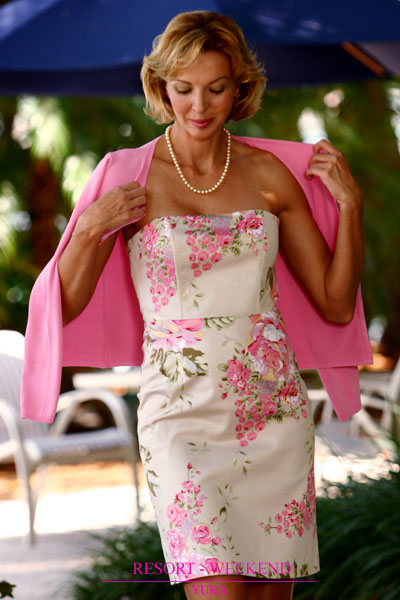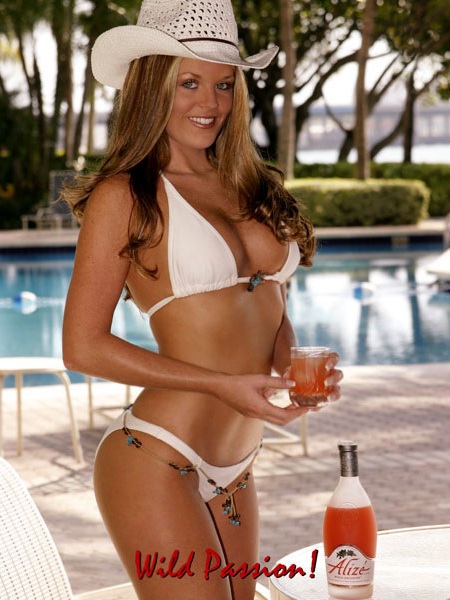An introduction to commercial modeling
Commercial modeling is a huge field, encompassing most forms
of print modeling (modeling for photographers), and modeling which
doesn’t involve photography. I will start by discussing the
non-photographic areas of modeling.

Photographer: John Fisher; Model: Yuka
Promotional modeling
At conventions or trade shows, models are used as greeters at booths: they hand out literature, handle promotional items such a hats, t-shirts, key chains, and sometimes answer basic questions such as when seminars or demonstrations are scheduled. Yes, the girls are sometimes eye candy, but any good planner will tell you that the right model can increase traffic through a booth substantially.
For instance, one of the most successful models in the Washington market works two or three conventions or trade shows a month—she develops contacts with the marketing people who work the booths in order to get more print work. She has favorite clients and virtually all her print work comes from these contacts; she’s learned their product lines and is now considered an invaluable asset, often traveling (at corporate expense) to major cities for these companies when they are participating in a trade show. While most trade shows pay $100 to $300 a day, she now commands $500 a day plus coverage for certain expenses. Promotional modeling also includes passing out samples at cosmetic counters (often during the Christmas buying season) during special promotions arranged by the companies, and events like beer or liquor promotions (e.g., Bud Girls, Miller, or TQ Hot) at local watering holes. You must be 21 in most jurisdictions for these jobs.

Tea room modeling
This is typically a fashion show usually arranged by a local department store where clothes are shown in an informal atmosphere for select customers at the store or at a nearby restaurant. Sometimes the models are expected to be able to answer simple questions, like how comfortable the fabric feels, price points, and even cleaning instructions. Contacting department stores will allow a model to find out if these events occur in their area, as well as how they can apply to be considered for the work. Some of the major stores have teen boards, where local high school-aged models can find notices concerning local fashion shows. It’s a good way to get started, especially if you like fashion runway.
Now, the areas of commercial modeling that involve photography.
Commercial print modeling
Commercial print is what it sounds like—photographic advertising. Commercial print models can be any size, age, or body type, but they must be appropriate for the ad. While the vast majority of print models look like models (i.e., attractive), I worked in a print ad campaign where the art director told me they needed a thug, and, well, I looked like one! I also wound up in a movie because the roll called for a big, dumb, bald, white guy. It turns out that those qualifications are rather hard to find at your local agency.
Commercial print includes catalog modeling, beauty products, life style (such as models who appear in health club ads, vacation layouts, etc.), fashion ads (even those famous models doing Versace ads are doing commercial print, not editorial work), and anything where a model is used in an ad to sell a product or a service. Most glamour print modeling such as swimsuit calendars, posters, etc., are a form of commercial print work. The Sports Illustrated Swimsuit issue is editorial, and personally, I consider the Playboy centerfold (and only the Playboy centerfold) to be a form of editorial modeling, but more on that later.

Photographer: John Fisher; Model: Crystal Moyer
Most children are commercial models, and many industry observers consider the majority of male models to be commercial models. Models are used in television ads and instructional or corporate videos. This is a very specialized but lucrative area of modeling, which is why Malibu photographer Gino Cox often recommends getting involved in theater classes and school plays while you are still in school. You have to start somewhere, so why not while you are trapped in the educational system, anyway?
Commercial modeling is by far the largest and most diverse field of modeling, and while the average income of commercial models does not approach the levels of the top editorial models, many commercial models make very attractive incomes, and work steadily with long careers. In fact, in the U.S., the majority of agencies not located in New York are actually commercial agencies—this includes the branches of the majors like Ford and Elite (but don’t tell them I said so, they can be very touchy about this.)
Okay, this is a quick introduction to commercial modeling. I have hardly scratched the surface, but it will give you a sense of the breadth of the field.

Photographer: John Fisher; Model: Yuka
Promotional modeling
At conventions or trade shows, models are used as greeters at booths: they hand out literature, handle promotional items such a hats, t-shirts, key chains, and sometimes answer basic questions such as when seminars or demonstrations are scheduled. Yes, the girls are sometimes eye candy, but any good planner will tell you that the right model can increase traffic through a booth substantially.
For instance, one of the most successful models in the Washington market works two or three conventions or trade shows a month—she develops contacts with the marketing people who work the booths in order to get more print work. She has favorite clients and virtually all her print work comes from these contacts; she’s learned their product lines and is now considered an invaluable asset, often traveling (at corporate expense) to major cities for these companies when they are participating in a trade show. While most trade shows pay $100 to $300 a day, she now commands $500 a day plus coverage for certain expenses. Promotional modeling also includes passing out samples at cosmetic counters (often during the Christmas buying season) during special promotions arranged by the companies, and events like beer or liquor promotions (e.g., Bud Girls, Miller, or TQ Hot) at local watering holes. You must be 21 in most jurisdictions for these jobs.

Tea room modeling
This is typically a fashion show usually arranged by a local department store where clothes are shown in an informal atmosphere for select customers at the store or at a nearby restaurant. Sometimes the models are expected to be able to answer simple questions, like how comfortable the fabric feels, price points, and even cleaning instructions. Contacting department stores will allow a model to find out if these events occur in their area, as well as how they can apply to be considered for the work. Some of the major stores have teen boards, where local high school-aged models can find notices concerning local fashion shows. It’s a good way to get started, especially if you like fashion runway.
Now, the areas of commercial modeling that involve photography.
Commercial print modeling
Commercial print is what it sounds like—photographic advertising. Commercial print models can be any size, age, or body type, but they must be appropriate for the ad. While the vast majority of print models look like models (i.e., attractive), I worked in a print ad campaign where the art director told me they needed a thug, and, well, I looked like one! I also wound up in a movie because the roll called for a big, dumb, bald, white guy. It turns out that those qualifications are rather hard to find at your local agency.
Commercial print includes catalog modeling, beauty products, life style (such as models who appear in health club ads, vacation layouts, etc.), fashion ads (even those famous models doing Versace ads are doing commercial print, not editorial work), and anything where a model is used in an ad to sell a product or a service. Most glamour print modeling such as swimsuit calendars, posters, etc., are a form of commercial print work. The Sports Illustrated Swimsuit issue is editorial, and personally, I consider the Playboy centerfold (and only the Playboy centerfold) to be a form of editorial modeling, but more on that later.

Photographer: John Fisher; Model: Crystal Moyer
Most children are commercial models, and many industry observers consider the majority of male models to be commercial models. Models are used in television ads and instructional or corporate videos. This is a very specialized but lucrative area of modeling, which is why Malibu photographer Gino Cox often recommends getting involved in theater classes and school plays while you are still in school. You have to start somewhere, so why not while you are trapped in the educational system, anyway?
Commercial modeling is by far the largest and most diverse field of modeling, and while the average income of commercial models does not approach the levels of the top editorial models, many commercial models make very attractive incomes, and work steadily with long careers. In fact, in the U.S., the majority of agencies not located in New York are actually commercial agencies—this includes the branches of the majors like Ford and Elite (but don’t tell them I said so, they can be very touchy about this.)
Okay, this is a quick introduction to commercial modeling. I have hardly scratched the surface, but it will give you a sense of the breadth of the field.
No comments:
Post a Comment